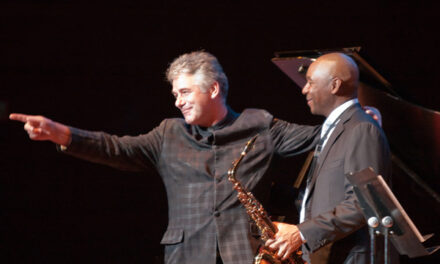There was a good turnout of music lovers in Dana Auditorium on the Guilford College campus. On stage was one of the Eastern Music Festival‘s two full-sized all student Young Artist’s Orchestras for two strongly contrasted and challenging twentieth century works. A deeply meditative work was paired with one making high technical demands from every player. On the podium was conductor Grant Cooper.
Schelomo: Hebraic Rhapsody for Cello and Orchestra (1911) is probably the most frequently programed work of Swiss-American composer Ernest Bloch (1880-1959). He makes use of bare fourths and fifths in his harmony combined with melodies, modal flavor, and freely flowing rhythmic quality to evoke spoken patterns without directly quoting actual Jewish songs. The Book of Ecclesiastes and the character of King Solomon served as inspiration. The cello, with its extensive cadenza-like solos, represents Solomon set against the orchestra, evoking his struggle with the world.
The festival’s principal cellist Neal Cary was the masterful soloist. The cellist must move skillfully across two octaves from the instrument’s lowest range to its most stratospheric highs. Cary’s intonation and phrasing were breathtaking! His color palette and rich, warm tone contributed to the suggestion of Solomon’s ruminations over the course of the work’s three continuous sections. Cooper led his musicians in alert accompaniments. The dynamics ranged from hushed pizzicatos to highly charged, intense series of climaxes.
Music festivals compete for the best students, and sure enticements are complex, large orchestral showpieces such as Petrouchka (1911), by Igor Stravinsky (1882-1971). The ballet plot is a Russian version of commedia dell’arte characters. The setting is a Shrovetide Fair in St. Petersburg, with three puppets: Petrouchka, a dancer (his love interest), and the showy Moor she fancies. The puppets come to life, the dancer rejects Petrouchka, and the Moor murders him. The ghost appears jeering everyone with the “Petrouchka chord,” C Major and F-sharp Major triads, first heard in the clarinets. It is in four tableaux divided into 15 numbers.
Cooper led his young musicians superbly through the challenges of multiple and rapidly shifting meters to a dazzling performance. Swirling woodwinds, surging strings, and driving rhythms evoked the bustling fair crowd. The clarinet brought just the right mixture of fruitiness and sass to the famous “Petroushka chord” in No. 2. Many numbers had a chamber-music quality with a focus on just a few instruments, such as the pungent bassoons and singing flute melody in No. 3, “The Charlatan’s Booth.” Fine oboe and violin solos juxtaposed a pounding piano rhythm in No. 4, “The Russian Dance.” The various percussion – timpani, snare drums, etc. – were glorious, as were the numerous trumpet and horn solos. The radiant, swirling solo trumpet in No. 7, “The Ballerina’s Dance,” was exemplary. Were contrabasses ever more threatening than in opening of the third tableaux? The musicians richly deserved the multiple curtain calls in response to the sustained standing ovation. Cooper had individual soloists and entire sections stand in turn.
Among the many fundraiser items in last spring’s gala fundraiser was a chance to conduct a student orchestra. Supporter Sue Starr bought this prize and opened the concert on the podium to lead the orchestra in John Philip Sousa’s “The Stars and Stripes Forever.” Save for a brief ragged start, she led a rousing performance with brilliant brass and percussion, rich strings, and strong woodwind contributions, not least from the enthusiastic piccolos!
The EMF continues through July 28. For details, see our calendar.












